It has been suggested that this article be merged with Municipal Court of Nauvoo to Nauvoo Charter . (Discuss) Proposed since July 2024. |

The Nauvoo City Council was a short-lived municipal body for the City of Nauvoo, Illinois.
It has been suggested that this article be merged with Municipal Court of Nauvoo to Nauvoo Charter . (Discuss) Proposed since July 2024. |

The Nauvoo City Council was a short-lived municipal body for the City of Nauvoo, Illinois.
The Nauvoo City Charter was passed by the Illinois Legislature on December 16, 1840. The legislature established the Nauvoo City Council, consisting of the Mayor, four Aldermen, and nine Councilors. By state law, each office held a two-year term.
According to the charter, members of the City Council also sat on the Municipal Court of Nauvoo – for example, the Mayor doubled in the role of Chief Justice.
In January 1845, the legislature repealed the Nauvoo Charter by a vote of 25-14 in the Senate and 75-31 in the House. [2] Nauvoo was dis-incorporated and its assets placed into a receivership.

Nauvoo is a small city in Hancock County, Illinois, United States, on the Mississippi River near Fort Madison, Iowa. The population of Nauvoo was 950 at the 2020 census. Nauvoo attracts visitors for its historic importance and its religious significance to members of several groups: The Church of Jesus Christ of Latter-day Saints; the Community of Christ, formerly the Reorganized Church of Jesus Christ of Latter-day Saints (RLDS); other groups stemming from the Latter Day Saint movement; and the Icarians. The city and its immediate surrounding area are listed on the National Register of Historic Places as the Nauvoo Historic District.
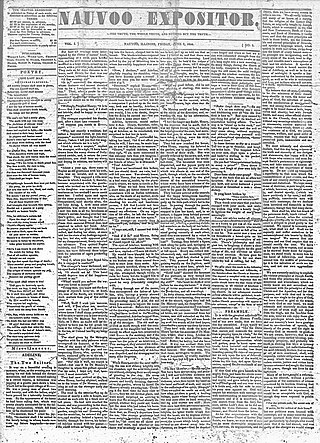
The Nauvoo Expositor was a newspaper in Nauvoo, Illinois, that published only one issue, on June 7, 1844. Its publication, and the destruction of the printing press ordered by Mayor Joseph Smith and the city council, set off a chain of events that led to Smith's murder.
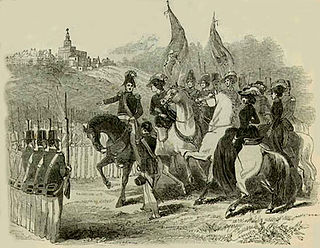
The Nauvoo Legion was a state-authorized militia of Nauvoo, Illinois, United States from February 4, 1841 until January 29, 1845. Its main function was the defense of Nauvoo and surrounding Latter Day Saint settlements, but it was also occasionally used as local law enforcement and paraded at ceremonies such as the laying of the cornerstone for the Nauvoo Temple. The Nauvoo Legion was unique among contemporary militias for its chain of command structure, its expanded functions of the court martial, and for operating at a city level.

Willard Richards was an early leader in the Latter Day Saint movement. He served as second counselor to church president Brigham Young in the First Presidency of the Church of Jesus Christ of Latter-day Saints from 1847 until his death.
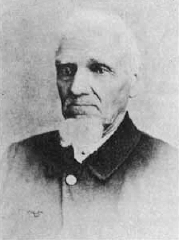
William Smith was a leader in the Latter Day Saint movement and one of the original members of the Quorum of the Twelve Apostles. Smith was the eighth child of Joseph Smith Sr. and Lucy Mack Smith and was a younger brother of Joseph Smith Jr., the founder of the Latter Day Saint movement.

Thomas Ford was a lawyer, judge, author and the eighth Governor of Illinois. The first Illinois governor to be raised in the state, he served from 1842 to 1846 and became known for restoring the state's solvency and reducing geographic sectionalism, as well as for leading the legislature despite his lack of prior political experience. A lifelong Democrat, Ford is also remembered for anti-Mormon sentiments and vacillation which led to the death of Joseph Smith, and the subsequent Illinois Mormon War of 1844-1845.

John Cook Bennett was an American physician and briefly a ranking and influential leader of the Latter Day Saint movement, who acted as mayor of Nauvoo, Illinois, and Major-General of the Nauvoo Legion in the early 1840s.
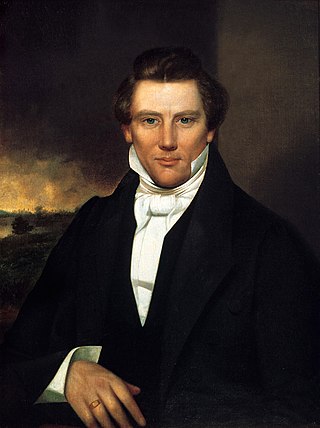
The life of Joseph Smith from 1839 to 1844, when he was 34–38 years old, covers the period of Smith's life when he lived in Nauvoo, an eventful and highly controversial period of the Latter Day Saint movement. In 1844, after Smith was imprisoned in Carthage, Illinois, he was shot and killed when a mob stormed the jailhouse.

George Hunter, JP was the first mayor of Wellington, New Zealand, in 1842–43. He was also the first mayor in New Zealand.
George Miller was a prominent convert in the Latter Day Saint movement and was the third ordained bishop in the Latter Day Saint church.

The Red Brick Store in Nauvoo, Illinois, was a building constructed and owned by Joseph Smith, founder of the Latter Day Saint movement.
The history of Nauvoo, Illinois, starts with the Sauk and Meskwaki tribes who frequented the area, on a bend of the Mississippi River in Hancock County, some 53 miles (85 km) north of today's Quincy. They called the area "Quashquema", in honor of the Native American chief who headed a Sauk and Fox settlement numbering nearly 500 lodges. Permanent settlement by non-natives was reportedly begun in 1824 by Captain James White. By 1830, the community was called "Venus", and it was the site of the first post office in the county. In 1834 the name Venus was changed to "Commerce" in anticipation that the town would prosper under the United States' westward expansion.
The University of Nauvoo was a short-lived university in Nauvoo, Illinois.
Vinson Knight was an early leader in the Latter Day Saint movement. He served as a counselor in the bishopric in Kirtland, Ohio, from 1835 to 1838, then as bishop in Adam-ondi-Ahman in Daviess County, Missouri, from 1838 to 1839, and finally as bishop of the Lower Ward in Nauvoo, Illinois, having been called by Joseph Smith through revelation to that office in January 1841. Knight served as bishop in Nauvoo until his sudden death at age 38.
James Emmett was an early American Latter Day Saint and for a time claimed to be the rightful successor to Joseph Smith, the founder of the Latter Day Saint movement.
The Municipal Court of Nauvoo was the judicial body of Nauvoo, Illinois from 1840 until 1845.

An attempted assassination of Lilburn Boggs occurred on May 6, 1842, when an unknown assailant fired buckshot into the home of Lilburn Boggs, striking the former Missouri Governor. Boggs was shot through a window as he read a newspaper in his study and was hit in four places: two balls were lodged in his skull, a third lodged in his neck, and a fourth entered his throat and was swallowed. Boggs was severely injured. Several doctors—Boggs's brother among them—pronounced his injuries fatal, and at least one newspaper ran an obituary. To general surprise, Boggs not only survived, but his condition gradually improved.
Lucian Rose Foster was a photographer, accountant, bookkeeper, and clerk who was a member of the Latter Day Saint movement.
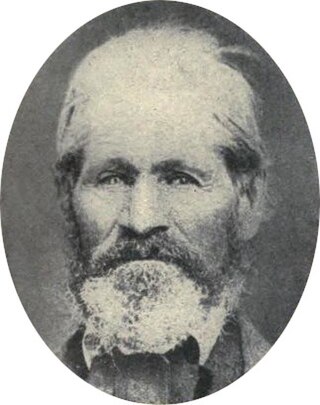
Charles Shumway (1806–1898) was an early member of the Church of Jesus Christ of Latter-day Saints who served as a member of the Council of Fifty and was part of the Utah Legislature for one term in 1851.